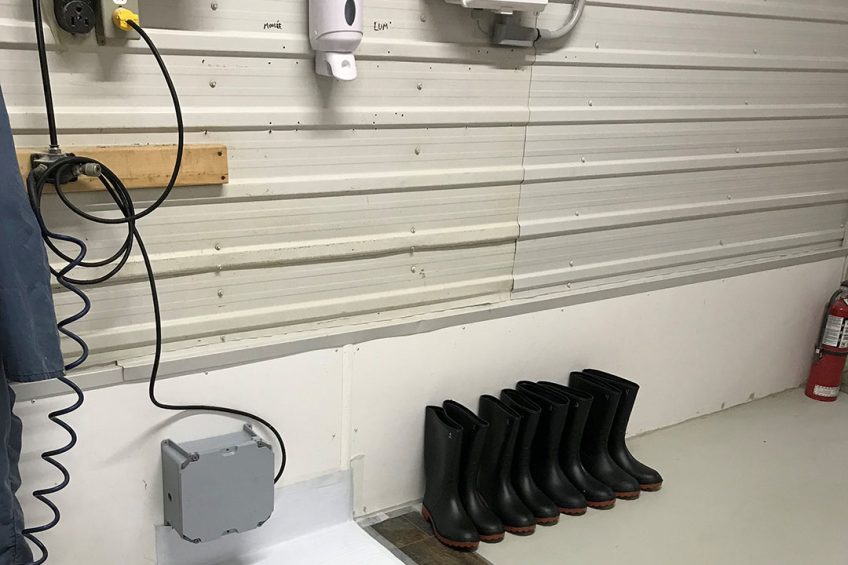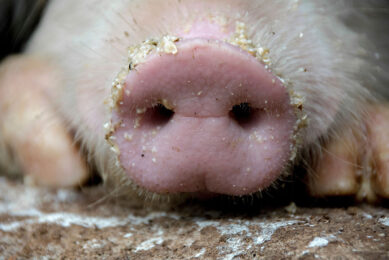Immediate ‘beep’ if pig farm biosecurity is ignored

A new preliminary study in Canada examines how technology used in hospitals can boost protocol compliance rates on swine and poultry farms.
No matter the type of farm, or generally where it’s located around the world, compliance with biosecurity protocols needs improvement. Yes, it is boosted upward at the time of an outbreak, but inevitably it drops down again.
Compliance is complex, noted Dr Manon Racicot, a veterinary epidemiologist at the Canadian Food Inspection Agency and an adjunct professor in the Faculty of Veterinary Medicine at the University of Montréal in Quebec, Canada, who has conducted several biosecurity studies with Dr Jean-Pierre Vaillancourt, professor in the university’s ‘Research Group on the Epidemiology of Zoonoses and Public Health.’
Watching a great deal of farm footage
Compliance is boosted to some extent by holding regular on-farm training and review meetings, and if the information is presented as important. The use of cameras can help in some instances, but Dr Racicot noted that even in situations where workers accepted them (and they used not to punish, but to reward), it’s not feasible because a manager would have to carefully watch a great deal of footage.
Providing adequate resources (adequate hand sanitiser, etc.) is also important in achieving biosecurity protocol compliance on farm. It is also aided by signs and other reminders, but they lose effect over time.
Instantaneous feedback using RFID
The lack of an effective solution is why Racicot is studying the application of instantaneous feedback, which has been shown to be a powerful compliance tool in many settings. She recently had an RFID tag system (similar to that which is being used to monitor healthcare workers in hospitals, tracking whether they visit hand-washing stations) in a barn in Quebec. So far, it’s only been a preliminary test to see how the system would work, and also how the workers feel about it (are the beeps annoying? did they feel they were under undue scrutiny?); testing on how it can be used to boost compliance will come later.
(Dr Racicot wanted a barn with many employees and happened to choose a layer barn with about 8 workers, but the principals are obviously the same not matter what type of livestock.)
RFID tags were placed in the personal shoes of workers, shoes they agreed to wear en route to the farm every shift during the 2-week study. Tags were also placed in farm boots. If personal shoes entered the ‘clean zone’ in the barn entry area, the system provided instant feedback by beeping (protocols were not being followed). In addition, if the hand sanitiser dispenser was not used, the system also provided a beep.
Feedback and wrong behaviour on farms
The system worked well and more studies will follow. Reflecting on where things will go, Dr Racicot said, “Research shows that you should get feedback as close as possible to the wrong behaviour, and that’s what this provides, but there is also value in feedback reports in terms of motivation.
She added, “There is a programme in France where hospital workers with RFID tags in their shoes received reports by text messages about their weekly performance with using sanitiser in each room they entered. The reports include comparisons with performance over previous weeks and with performance of colleagues. So, I’d like to investigate whether instantaneous beeps or weekly reports work best, or both. There are no studies on this.”

Read more about pig health in the Pig Progress Health Tool
Instant feedback might be useful
Dr Racicot said, “We know there is a lot of staff turnover on farms. So instant feedback might be useful, but if there is no tracking which could lead to rewards and also if we are not motivated through our performance being compared with previous weeks and other workers, it’s not going to help. From a social science perspective, it’s well established that peer comparison works and incentives work.”
Dr Racicot would also like to use the ‘beep’ system to evaluate training programmes. “Right now, we have no idea if training works or not or if some programmes are better than others,” she said. “We would do a baseline test, then do the training programme, and then test again.”
 Beheer
Beheer








 WP Admin
WP Admin  Bewerk bericht
Bewerk bericht